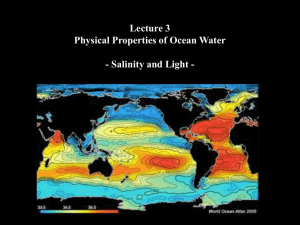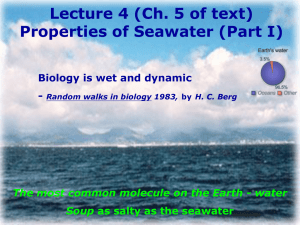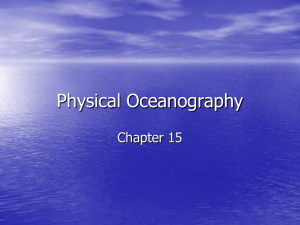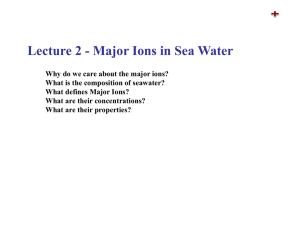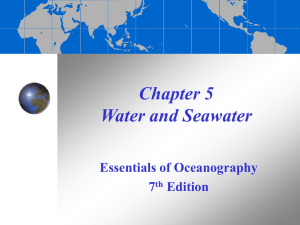g104_class5_properties_of_seawater
advertisement
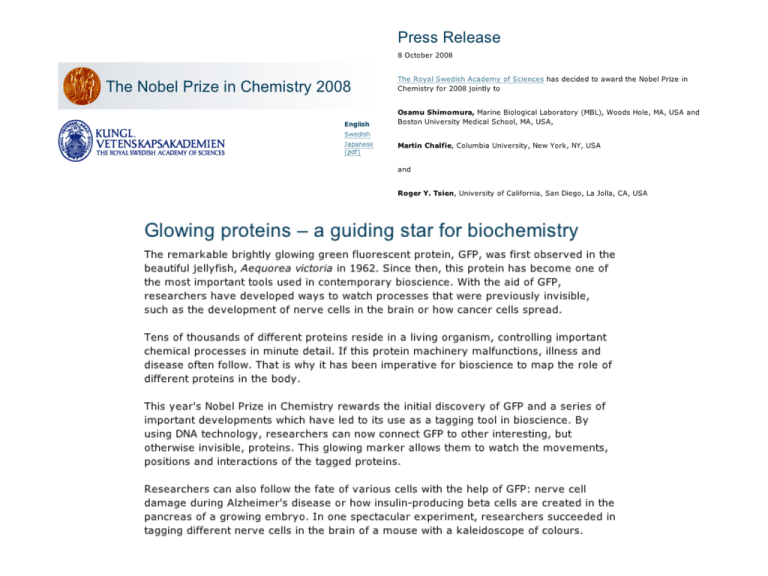
Geography 104 - “Physical Geography of the World’s Oceans” Properties of Seawater Last time talked about properties of water (Table 7.2) - dissolves solids and gases readily (“universal solvent”) Addition of dissolved solids over geologic time (billions of years) has converted pure water to “salt water” or seawater. Dissolved solids change water properties significantly: - density (very important for ocean circulation) - freezing point A salt, in chemistry, is an ionic compound composed of cations (positively charged ions) and anions (negative ions) so that the product is electrically neutral (without a net charge). Salts are formed by a chemical reaction between: - a base and an acid, e.g. NH3 + HCl → NH4Cl - a metal and an acid, e.g. Mg + H2SO4 → MgSO4 + H2 - a base and an acid anhydride, e.g. 2 NaOH + Cl2O → 2 NaClO + H2O - an acid and a basic anhydride, e.g. 2 HNO3 + Na2O → 2 NaNO3 + H2O -salts can also form if solutions of different salts are mixed, their ions recombine, and the new salt is insoluble and precipitates (see: solubility equilibrium), for example: Pb(NO3)2(aq) + Na2SO4(aq) → PbSO4(s) + NaNO3(aq) sources of salt ions sources sinks hydrogen bonds electrical attraction between water molecules water as a solvent salt has alternating ions; water molecules work their way between salt ions water as a solvent ocean dissolved or “hydrated” salt ions have a charged attraction to water molecules and thus move exactly with the individual water molecule to which they are attached solid salts would sink under gravity dissolved solids in seawater 99.9% of dissolved solids 99.3% < 1% dissolved solids in seawater principle of constant proportions – ratio between major ions is nearly constant by weight and independent of salinity concentration, thus need to measure only a single ion this is true for “open ocean” waters ratios not exact for “coastal” waters First salinity measurements: S = 1.80655 x Cl (ppt) salinity salt content of seawater quantified by salinity (S) salinity – mass of salts (dissolved solids) per kg seawater salinity units – parts per thousand (ppt or o/oo) 1g salts / 1kg seawater = 1 ppt typical open ocean salinity S = 35gsalts / 1 kgsw dissolved solids in seawater Pure seawater by mass ~96.5% water ~3.5% “salts” (salinity) 35 ppt or o/oo on average 33 -> 38 ppt in open ocean minor constituents < 1 ppm essential to marine organisms, and also used as “tracers” in physical oceanography atmospheric deposition of iron nutrients for biological oceanography NO3 – nitrate NO2 – nitrite NH4 – ammonium Si: SIO4 – silicate P: PO4 – phosphate N: nutrients: Atlantic vs. Pacific phosphate nitrate silicate Necessary for primary production, depleted in surface due to PP uptake, nutrients accumulate over time in deeper water time (decomposition of particles). Differences in curves show “age” of water. residence time of water in the atmosphere precipitation and evaporation cause variations in salinity residence time of water in the atmosphere reservoir amount: Q = (4.5+11)x1015 kg = 15.5x1015 kg residence time of water in the atmosphere outflow: Qout = (107+398)x1015 kg yr-1 = 505x1015 kg yr-1 inflow: Qin = (71+434)x1015 kg yr-1 = 505x1015 kg yr-1 inflow = outflow => steady state residence time of water in the atmosphere residence time = reservoir amount / flow amount 15.5x1015 kg = .03 yr = ~ 1.5 weeks 505x1015 kg yr-1 reservoirs of dissolved solids measurement of salinity, or “collection of salinity profiles” CTD or Conductivity Temperature Depth sensor is the workhorse of physical oceanographic measurements CTD measures conductivity, temperature, and pressure, to give ocean water salinity, temperature, as a function of depth. measuring salinity with electrical conductivity measurement standard and units developed in 1978 gave rise to: practical salinity units (psu) practical salinity scale (pss) oceanographers are very loose with salinity units: ppt, psu, pss, no units. measuring salinity with electrical conductivity 1. measure temperature (and pressure) 2. measure conductivity 3. derive salinity horizontal interleaving of water masses Fig. 7.15.c World Ocean Circulation Experiment (WOCE) Section P16 – salinity along 150° W salinity fronts Readings for next time (more properties of seawater, gases): - should have read all of Chapter 6, and reader article on salinity (pgs 13 – 22). - read reader articles on Fate of Carbon Dioxide (pgs 23 - 24) - read reader article on hypoxia (pgs 25 – 29) Get a start on first half of HW problems! My Seawater Summary Water has hydrogen bonds, electrical attraction between molecules. Salts have alternating ions. This combination of chemical compositions allows water molecules to dissolve salts. There are 11 major salt constituents. They exist in constant proportion, which allows total salts to be determined from the measurement of the mass of a single ion. Six (6) are generally considered because the combination of the 5 with the least concentrations comprise < 1% of the total weight of salts. Salinity (S) is defined as the mass of salts per kg seawater. S is measured in ppt (o/oo). S = 1 ppt = 1 g salts / 1 kg seawater. Open ocean S values average ~35 ppt and range from ~33 to 38 ppt. Values can be higher in small enclosed water bodies and lower in coastal areas. The ocean also has minor constituents that have negligible contribution to S, but are important for primary production and for tracing the “age” of water. Evaporation and precipitation are responsible for variations in S. The hydrologic cycle was used to demonstrate the idea of residence time for a steady state process. Residence times of salt ions are very long,1000’s of years and greater. CTD’s are used to measure conductivity, temperature and pressure profiles. Salinity is determined by conductivity in psu, or pss units. But, any all or no units are now used. There is structure with depth related to density that we’ll learn about next week. S at sea surface shows spatial structure. Atlantic saltier than Pacific due to evaporation over Atlantic trades blowing and precipitation in Pacific. Fresher in polar regions due to snow melt, fresher in coastal regions due to river runoff.



